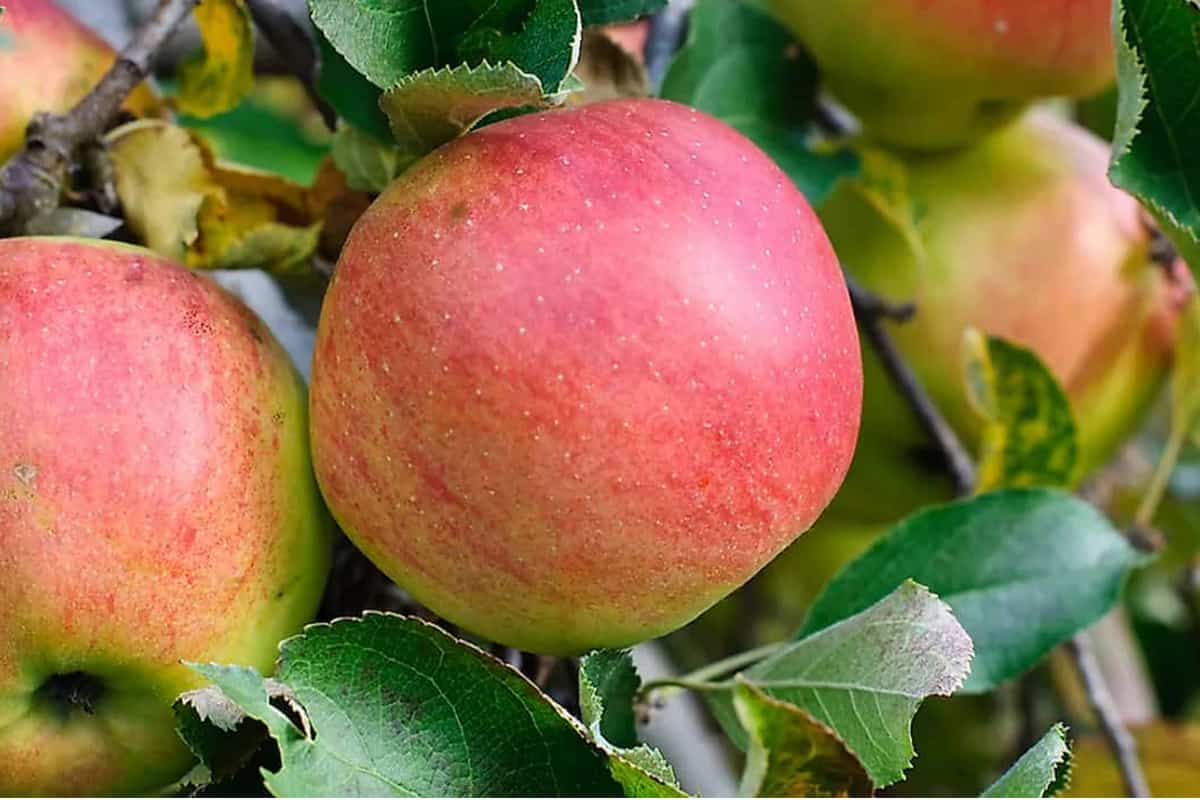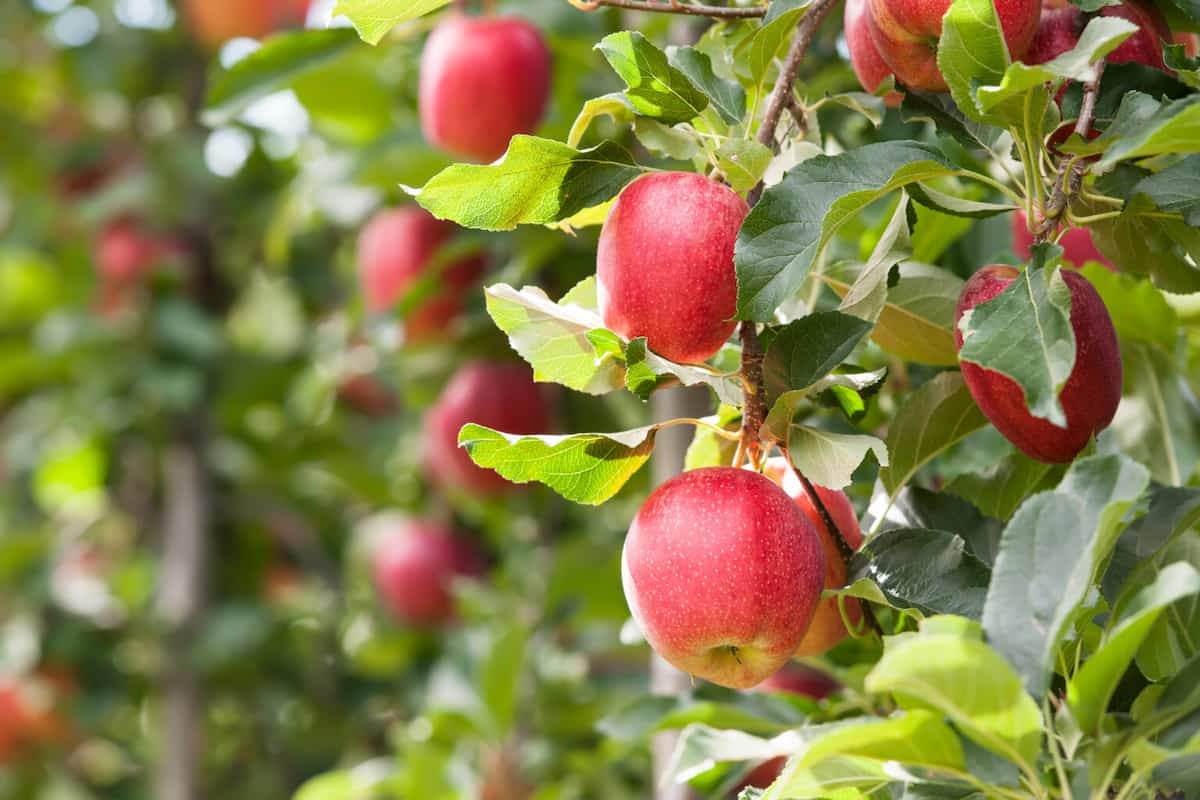The high benefits and fiber content of Baldwin apples make them an excellent choice for maintaining digestive tract health. In addition, this apple tree has a high concentration of vitamin C, which is beneficial to the immune system, and some potassium, which contributes to the maintenance of normal fluid levels in the body. Because the Baldwin apple has a lower concentration of sugar than other varieties of apple, it is reasonable to assume that it has fewer calories overall than the average of fifty-two that are found in other varieties of apple. The Baldwin apple is a medium to large variety, measuring between 6 and 8 centimeters in diameter on average. Its shape ranges from round to conical, and it is slightly misshapen. The apple's skin is thick, becoming tough and chewy as it ripens, and has a matte appearance with some russet and yellow lenticels. The apple's flesh is crisp and juicy. In addition, the base of the skin is yellowish green, and it is covered in a vibrant reddish-orange blush that is striped. Underneath the surface, the flesh is coarse, aqueous, and dense with a texture that is both crisp and firm. It ranges in color from white to ivory and has a greenish tint.

In addition, the full has a small central core that's packed with teeny-tiny brown and black seeds. The high acidity and sugar content of Baldwin apples are two factors that contribute to the fruit's sweet-tart flavor, which is then followed by warm, fruity, and aromatic nuances that are filled with spice. The fall and winter months are perfect for picking up some Baldwin apples. Baldwin apples, also known as Malus Domestica, are a variety of apples that ripens in the middle to late part of the growing season and are a member of the Rosaceae family. The heirloom apple variety was found to be growing as a chance seedling in a Massachusetts orchard in the late eighteenth century. It is considered to be one of the oldest apple varieties in the New England region. The sweet-sour taste and dense, crunchy texture of Baldwin apples made them a popular cultivar for home and commercial gardens throughout the 19th and early 20th centuries. Baldwin apples were prized for their unique combination of these flavors. The apples were traditionally used to make ciders, in addition to the fruits, which were considered to be an all-purpose cultivar. The fruits were utilized in both raw and cooked preparations. Baldwin apples are also referred to as Woodpecker apples, Pecker apples, Butter's Woodpecker apple, Steele's Red Winter apple, CalviButter apple, Butter's apple, Felch apples, and Red Baldwin's apple. Other names for Baldwin apples include Butter's apple and Steele's Red Winter apple.

These descriptors were assigned to the variety over the course of time as the apples went through a series of ownership transitions and were sold by a number of different farmers during the early stages of the apple's introduction to the commercial market. The prolific nature, thick skin, and extended storage capabilities of Baldwin apples made them a favorite among growers. These characteristics made it possible for the apples to be transported to Europe without suffering any damage to their external appearance. Baldwin apples have become a rare variety in the modern era because they have been overshadowed by other commercial cultivars. Nevertheless, the apples have maintained a small following in the northeastern United States, where they are grown as a boutique variety through specialty and private orchards. Baldwin apples are an excellent source of fiber, which helps to keep the digestive tract healthy, potassium, which helps the body maintain a healthy fluid balance, and vitamin C, which helps to keep the immune system strong. In addition, apples have trace amounts of zinc, iron, copper, and magnesium, as well as the bone-building minerals calcium, phosphorus, and boron; vitamin E, which shields cells from damage caused by free radicals; vitamin A, which ensures that organs continue to operate normally; and other vitamins and minerals in lower concentrations. Apples of the Baldwin variety have a flavor that is both sweet and sour, making them an excellent choice for both raw and cooked applications. The apple skins are tough and chewy, and when the apples are eaten fresh, the skins can either be peeled off or left on, depending on the consumer's preference.

In addition, Baldwin apples can be sliced and dipped in caramel, chocolate, or nut butter; layered into sandwiches; placed on toast; chopped into salads, slaws, and fruit bowls; or quartered and displayed on cheese plates. All of these preparations can be done with the apples. The apples can also be combined into grain bowls, blended into smoothies, or used as a fresh topping for breakfast foods like oatmeal, waffles, and pancakes. Another option is to use the apples in a smoothie. In addition to being used in fresh preparations, Baldwin apples are famous for the sweet-tart juice that they produce, and for more than two hundred years, this juice has been widely used in cider blends across the United States. The apples have a high concentration of sugar, and when the flesh is fermented, the sugar transforms into approximately 6% alcohol with overtones of melons and citrus fruits. When baked goods such as pies, tarts, muffins, crisps, and cobblers are being made, it is common practice to combine Baldwin apples with tarter apple varieties in order to create a multi-layered flavor profile. The apples retain their shape quite well during the cooking process. When sauteed in butter and spices, apples take on a caramelized flavor that is both sweet and savory. Apples can also be cooked down into a puree and used as a sauce for roasted meats, or they can be hollowed out and baked as a nutritious dessert. Spices such as cinnamon, cloves, ginger, and nutmeg, vanilla, and nuts such as walnuts, pecans, pistachios, and almonds are excellent complements to Baldwin apples.

Dried fruits such as cranberries, raisins, figs, and cherries are also delicious when combined with Baldwin apples. When kept in the crisper drawer of the refrigerator or in cold storage, whole Baldwin apples that have not been washed will keep for one to four months. A monument can be found in Wilmington, Massachusetts, which marks the location of the first apple tree to bear the Baldwin name. The Rumford Historical Association of Woburn was responsible for the construction of the monument in 1895. It is comprised of a stone pedestal that is five feet tall and has a carving of a Baldwin apple on top of the base that is rectangular in shape. In addition, there is an inscription that details the history of the apple, and the first version of the inscription gave surveyor Samuel Thompson the credit for discovering the apple. It took over 60 years to make the necessary changes to the inscription, which involved changing the text so that the origins of the variety's name, which was given in honor of Colonel Loammi Baldwin, were included. The Baldwin apple Monument is one of the few monuments that are still in existence in this day and age that is dedicated to a particular apple variety. A statue of Colonel Loammi Baldwin was erected in Woburn, Massachusetts. At the base of the statue is a plaque that discusses Baldwin's well-known role in the promotion of Baldwin apples. The Baldwin Apple Monument is approximately two miles to the north of this statue, which is significant due to the fact that Baldwin was a prominent historical figure during the 19th century.
